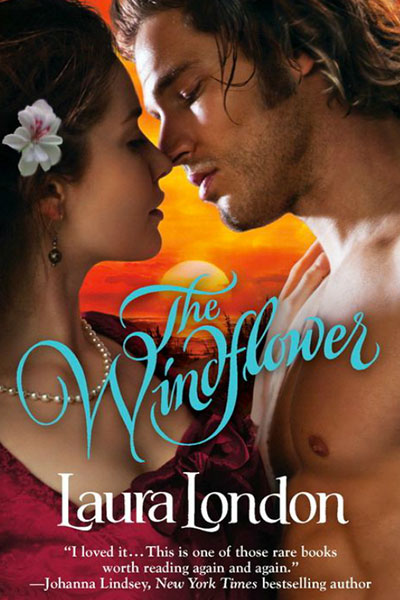5 Reasons Romance Fans Will Love The Windflower
 For as long as I’ve been reading romance, there’s been one novel that had, until recently, remained maddeningly out of reach. I first heard of Laura London’s The Windflower about 15 years ago, when a blogger mentioned it in passing, proclaiming it a classic. From that moment, I knew I had to get my hands on The Windflower.
For as long as I’ve been reading romance, there’s been one novel that had, until recently, remained maddeningly out of reach. I first heard of Laura London’s The Windflower about 15 years ago, when a blogger mentioned it in passing, proclaiming it a classic. From that moment, I knew I had to get my hands on The Windflower.
This turned out to be much easier vowed than done. Laura London is the pen name of husband-and-wife authors Tom and Sharon Curtis. Published in 1984, The Windflower was long out of print—despite fans extolling its genius and encouraging others to obtain a copy. Occasionally I would see used copies for sale on auction or marketplace sites, but they were always selling for upwards of $200 or $300 a pop—for a worn, dog-eared mass market paperback from 1984! I tried every library and interloan system I could think of, and still…nothing.
Then, just by chance, I was walking through Barnes & Noble earlier this summer, and I came across a huge display of The Windflower! The publishers must have heard the outcry from romance fans like me, and they had finally reissued this legendary—and legendarily elusive—novel.
I savored the experience of reading The Windflower. I knew from the first line that it was going to draw me in and take me on a crazy adventure, and that it did. From Virginia to the high seas, from a tropical island marooning to the drawing rooms of upper-crust London society, this book was a rollicking good time. I could probably make a list of 100 reasons, but here are just five reasons that you, too, should read The Windflower.
The writing
Every genre has its share of great to less-great writers, and romance is no different. What Laura London/the Curtises have done in The Windflower is really quite impressive: they’ve kicked the bar up a few notches in terms of writing quality, while still managing to have fun.
For instance, take the novel’s opening line: “Merry Patricia Wilding was sitting on a cobblestone wall, sketching three rutabagas and daydreaming about the unicorn.” When I first read this, I inwardly screamed, “ZOMG!” Let’s all just take in how amazing that sentence is:
- There is a lady with the fantastically strange name of Merry Patricia Wilding.
- She’s sitting on a cobblestone wall, so it’s Old Time-y (set around the War of 1812, to be exact, an era of history rarely utilized in romance novels, so—another point for The WF!).
- She’s sketching RUTABAGAS, that most homely and underappreciated of all root vegetables!
- And she’s daydreaming about…the unicorn. UNICORN. (I should probably interject here that The Windflower is not at all a fantasy novel. The unicorn has a tiny but pivotal role in Merry’s dreaming life.)
This is but one example of London’s interesting, amusing, and sometimes even poetic style.
The supporting players
A great novel makes its minor characters just as fascinating as its major characters, and this is a talent London has in spades. Every character, no matter how minor, is given a chance to shine, thereby allowing us a peek into the little corner of the world inhabited by each. The most indelible supporting players in The Windflower are undoubtedly Devon’s fellow pirates, Merry’s stick-up-her-tuchus Aunt April (who’s actually quite fabulous), and the Baddie McBadderson of the story: Sir Michael Granville.
Our hero, Devon
London isn’t afraid to craft complicated characters, and a good case in point is Windflower hero Devon. He’s tall, buff, blond, and second-in-command of the most feared ship on the high seas. But Devon, like most of London’s characters, is far more than a pretty picture. He is a man battling his head for the truth only his heart seems to accept. Even though we’re supposed to think of Devon as a classic, immoral rake, he’s really not. He’s a smooth-talker, for sure, but he’s also wickedly sarcastic, funny, and beneath the nonchalant exterior, one helluva nice guy.
Our heroine, Merry
She’s virginal, innocent, and seemingly content in her quiet Virginia life. But Merry Wilding is no Mary Sue, no matter how you slice it. Yes, she’s undoubtedly naive…but homegirl is fierce. She may not know the ways of the world, but that doesn’t mean she won’t enter said world without a quick-thinking wit and razor-sharp intelligence. London beautifully balances Merry’s naiveté with her innate hellcat nature. As a result, we have a heroine who is inexperienced but not stupid, a truly good person who is not a goodie-two-shoes, and a savvy young woman who uses her brain.
Ambiguously gay pirates!
Of course a ship full of swarthy men, alone for weeks and months at a time together, is bound to raise some questions. But there is one relationship in particular that The Windflower purposely leaves a little vague. Rand Morgan, the sexy, raven-headed commander of the pirate ship (and the most notorious pirate of his day), has an incredibly intense relationship with one of his subordinates, the blond, sparkly-eyed, and altogether enchanting Cat. At more than one point, I began to question the exact nature of Rand and Cat’s relationship; while nothing overt happens, there is more than a little innuendo. While in the end, London provides a sort of explanation for their bond, there’s still enough there to keep the reader guessing.
Have you read this modern-day classic?